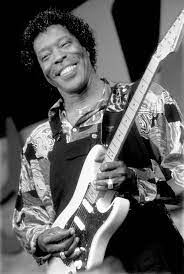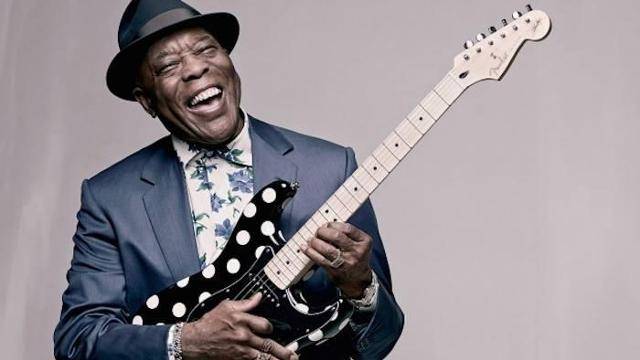Buddy Guy: A Complete Biography
Introduction
George “Buddy” Guy is a towering figure in the world of blues music. Known for his fiery guitar playing, passionate vocals, and energetic stage presence, Guy played a pivotal role in shaping the Chicago blues sound. His influence spans generations, inspiring legends like Jimi Hendrix, Eric Clapton, Stevie Ray Vaughan, and John Mayer. With a career spanning over six decades, Buddy Guy remains not only a torchbearer of traditional blues but also a vibrant, evolving artist in his own right.

Childhood
Buddy Guy was born George Guy on July 30, 1936, in Lettsworth, Louisiana. The son of sharecroppers, he grew up in humble surroundings, often helping his family with labor-intensive work. Despite the challenges of poverty and segregation in the rural South, Guy found an early love for music. He was captivated by the raw sounds of blues artists such as Lightnin’ Hopkins and Muddy Waters, which he would hear on the radio or through family gatherings.
As a child, he built his first makeshift guitar using wires pulled from the screen door and wood from his family’s home. Music became a source of escape and expression, planting the seeds of a legendary career.
Youth
During his teenage years, Guy began experimenting with the guitar more seriously. He listened avidly to records by B.B. King and T-Bone Walker and learned to replicate their licks. After high school, he worked various odd jobs, including as a custodian and gas station attendant, but music remained his passion.
In 1957, seeking better opportunities, Guy moved to Baton Rouge where he played in clubs and began gaining a reputation as a skilled guitarist. His first recordings, though primitive, caught the attention of a few industry figures. It was in this period that he began to develop the blend of traditional blues and flamboyant guitar solos that would define his style.
Adulthood
In 1957, Guy took a bold step and relocated to Chicago, the mecca of electric blues. He quickly found work on the competitive club scene, participating in legendary “cutting contests” with other aspiring guitarists. His breakthrough came when blues icon Muddy Waters took him under his wing and helped him navigate the local industry.
Guy signed with Chess Records in 1958, but the label didn’t fully understand his innovative sound. As a result, many of his early recordings were shelved or heavily edited. Nevertheless, he became a sought-after session musician, playing on records by Howlin’ Wolf, Little Walter, and Koko Taylor.
In the 1960s, Buddy Guy formed a successful partnership with harmonica virtuoso Junior Wells. Together, they toured extensively and released several acclaimed albums, including “Hoodoo Man Blues” (1965), considered one of the finest Chicago blues albums of all time.
Despite his influence on the rock guitar revolution, Guy struggled with commercial success for many years. It wasn’t until the late 1980s and early 1990s that he gained mainstream recognition, largely thanks to the advocacy of British and American rock stars who cited him as a formative influence. In 1991, he released the Grammy-winning album “Damn Right, I’ve Got the Blues,” which revitalized his career and introduced him to a new generation of fans.
Major Compositions
Throughout his prolific career, Buddy Guy released numerous albums and songs that left a mark on the blues and rock world. Among his most celebrated works are:
- “Stone Crazy” – A ferocious blues number showcasing his unrestrained guitar technique and emotional intensity.
- “Damn Right, I’ve Got the Blues” (1991) – The title track of the album that relaunched his career, blending classic blues with modern production.
- “Feels Like Rain” (1993) – A soulful ballad that featured collaborations with John Mayall and Bonnie Raitt.
- “Slippin’ In” (1994) – A Grammy-winning album that continued his creative resurgence.
- “Born to Play Guitar” (2015) – Released at age 79, this album debuted at No. 1 on the Billboard Blues Chart and reaffirmed his vitality and artistry.
Guy has won eight Grammy Awards and was inducted into the Rock and Roll Hall of Fame in 2005 by B.B. King and Eric Clapton. He has also received the National Medal of Arts (2003) and the Kennedy Center Honors (2012), cementing his status as a cultural icon.
Death
As of August 2025, Buddy Guy is still alive. Though he announced a farewell tour—aptly named “Damn Right Farewell”—he continues to perform select shows, record new material, and mentor young musicians. His enduring presence on stage and in the studio is a testament to his passion and resilience.
Conclusion
Buddy Guy’s legacy is monumental. From a young boy in rural Louisiana plucking makeshift strings to an international blues ambassador, Guy embodies the spirit of American music. He bridged the gap between the raw power of traditional blues and the electrifying energy of modern rock, leaving an indelible imprint on both genres.
His life is not only a story of musical brilliance but also one of perseverance, innovation, and generosity. By championing the blues and mentoring the next generation of artists, Buddy Guy has ensured that the soulful cry of the blues will continue to echo long after the final note fades.

Comments are closed